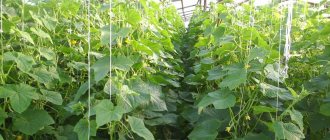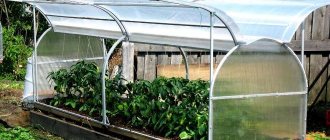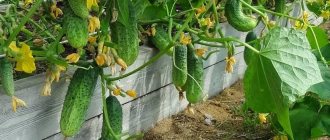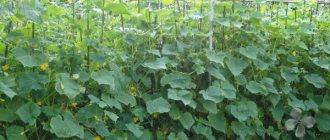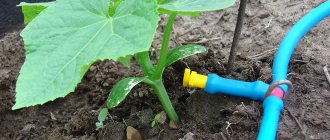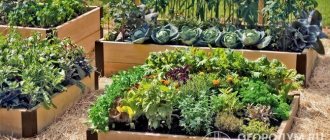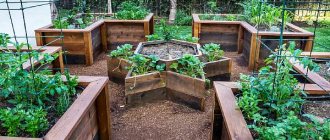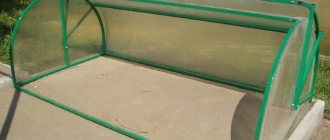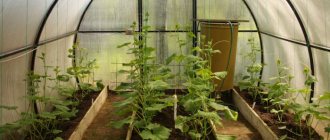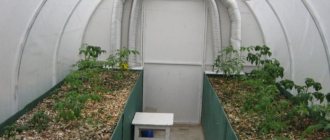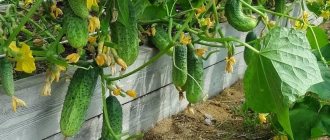Getting an early harvest of cucumbers is the dream of any gardener. For a heat-loving culture, sun rays alone are not enough. Creating certain conditions will speed up the process of fruit ripening. A warm bed is what you need to speed up the early harvest. It turns out that without a greenhouse or greenhouse it is possible to grow an early harvest without additional financial costs, using natural biochemical processes.
When is it better to make warm beds: in spring or autumn?
Many will be surprised, but it is possible to get an early harvest of cucumbers without a greenhouse. For this purpose, warm beds are used. They work using thermal energy, which is generated as a result of complex physical and biochemical processes. This is a natural heating pad that helps plants develop faster and survive temperature changes. They are made from grass and organic fertilizers. Plus, decaying organic matter forms nutrients. We discussed the general rules for creating warm beds in this article.
Fertilizers begin to rot, release heat, and a reaction occurs - exothermic, in which aerobic and anaerobic bacteria participate. In the early stages, the temperature does not rise much, but every day it grows higher and higher.
You can prepare structures both in spring and autumn. To form beds in the fall, you have more plant material to fill the bed, which will be much fresher than in the spring. This includes any garden waste: leaves, branches, sawdust, twigs, stems, fruits, etc. In addition, in the fall there is more time for harvesting material and the temperature is suitable and the humidity is high. You can start cooking after harvesting; there is no need to rush anywhere. By spring, the soil will be sufficiently fertilized, all plant components will have time to rot and turn into compost. A good warm bed can last from 3-4 years to 7-8 years.
When and how to plant cucumbers in a warm bed
One of the advantages of a warm bed is earlier planting than in open ground. This is possible due not only to the rotting of organic matter and heating of the soil from below, but also to another design feature: arcs are placed on top of the bed and agrofibre and/or film is stretched. You can plant cucumbers in such a greenhouse a week or even two before the end of return frosts, that is, in the same time frame as in a summer greenhouse.
A covered warm bed is a greenhouse heated from above and below
However, there is a very important nuance in this method. On warm days, the temperature in the garden bed under the covering material, and even on rotting organic matter, can rise significantly, the cucumbers will burn. Such beds should be made by those who have the opportunity to open/cover cucumbers every day. Our grandmothers made it simpler: they sowed seeds in holes and covered them with square pieces of glass taken from old window frames. When the shoots appeared, the glass was removed. No covering materials were used. You can adopt this method, but then the sowing dates are shifted to the end of May - beginning of June, when it will be warm not only during the day, but also at night.
Pros and cons of warm beds in open ground
Cucumbers are grown in different conditions: a greenhouse, on a vertical trellis, in barrels, boxes and open ground. But the main problem of every gardener is providing sufficient heat. Cucumbers require at least 15 degrees, but a stable average daily temperature occurs in the middle zone in June.
Therefore, for an early and high-quality harvest, it is worth taking auxiliary measures. The ideal solution is warm beds. Their advantages over other types are as follows:
- Little labor intensity. It’s easy to form, even a beginner can handle it. Plus it lasts for several years.
- Disposal of garden waste such as plant debris, branches, leaves, fruits. Everything is suitable for creating warm beds.
- They can be planted in the spring, when the heat from organic components warms the ground.
- There is no need to apply additional inorganic or mineral fertilizers. Organic matter, which decomposes inside the bed, provides the plants with all the necessary substances.
- The ripening of the crop occurs much faster, and there are also fewer problems with its quality.
- The arrangement of the bed provides natural drainage to the plants.
Among the disadvantages are usually difficulties with formation and maintenance after winter. It is also important to select the correct proportions of biomaterial so as not to ruin the plantings.
Growing Shosha cucumbers.
To learn more
Advantages and disadvantages
In order for cucumbers to begin to bear fruit earlier, they try to provide them with optimal thermal conditions. The use of a heated bed allows you to accelerate plant growth and protect young shoots from spring frosts. Other advantages include:
- increased productivity;
- possibility of using organic waste;
- good drainage - water does not accumulate on the soil surface;
- high rate of soil heating;
- simplicity and economy.
You may be interested in:
We grow cucumbers in shells. Cucumbers are capricious plants. Seedlings do not always sprout, and if they sprout, it is difficult to transplant them, and if they are transplanted, they do not...Read more...
In addition, a layer of humus or compost creates a natural barrier against the spread of weeds and pests. The idea of recycling plant waste is very attractive: a large amount of mown grass and foliage accumulates in the garden, which needs to be disposed of. Using them to heat the bed allows you to destroy waste and create the necessary conditions for growing cucumbers. The disadvantages include:
- frequent watering (due to the layered structure, the top layer of soil dries out quickly);
- the need to apply mineral fertilizers every two years.
Setting up a warm bed for cucumbers
What to fill with
Almost any organic matter is suitable for filling: branches and trunks of felled trees, fruits, leaves, sawdust, weeds. Conventionally, the material is divided into fresh green and brown.
When forming, it is important to know that when green organic matter rots, nitrogen is released. It speeds up processes, but ammonia is released along with it. But this is a serious disadvantage, because it kills the bacteria involved in the process. As a result, the entire process will stop and heat will no longer be released.
The brown part promotes the release of carbon as well as hydrogen. Together, both gases turn into methane. This swamp gas is explosive, so be careful around these structures.
In order for the structure to help harvest the crop without causing inconvenience, it is important to maintain a 1:3 proportion of green and brown material. To create, take no more than 20-25% of fresh leaves and grass, the rest should be branches, sawdust, brushwood. Thanks to them, the reaction will be long-lasting and beneficial for vegetables.
Making a warm bed with your own hands is not difficult, the main thing is to follow the technology. Essentially this is a compost pit. The key to a correct reaction, the absence of mold, the development of disease, the bed must be constantly moistened and not disturb the supply of oxygen.
How to fill a warm bed
Create structures in the following stages:
- The base consists of large, long-decomposing material. Stumps, trunks, stalks from corn, Jerusalem artichoke, sunflower, and large branches are suitable. Plus you get excellent drainage for air exchange. The layer should be loose and at its highest more than 0.4 m.
- Before laying the next layer, thoroughly water the previous one.
- Next, lay newspaper, paper or cardboard. It is advisable to crumble and tear everything.
- Next layer: branches of bushes or trees.
- Then they lay down foliage, plucked grass, and tops.
- The final layers are compost or rotted manure, a layer of earth or garden soil.
But these are general recommendations; depending on the type and size of the structure, some layers can be removed. Each layer should be lighter than the previous one and from 5 to 15 cm thick. Instead of leaves, flowers, tops, and peelings are suitable. You can also line each layer with straw or thin branches so that everything does not turn into lettuce due to melting snow.
Instead of compost, rotted manure and humus are suitable.
Use only plant waste from healthy plants, free from fungi and pests. Also, you should not bury plants with seeds, otherwise they will germinate along with the cucumbers.
Another important point is protection from rodents. Line the bottom with a metal mesh.
Spring soil preparation
If the beds could not be improved in the fall, it must be done in the spring. There is no need to add lime substances; you can use liquid alkaline organic fertilizers. Dig up the soil, deepening the shovel by 25-30 cm.
Level a 12 cm layer with a rake, mixing it with a large amount of humus. It is prepared using sawdust, dried grass, fallen leaves, straw, manure, pieces of paper, etc. The bed is moistened and covered with film so that the earth warms up. These activities are carried out several days before planting the crop.
The soil for cucumbers, dug up and fertilized in the fall, should be loosened in the spring. It is necessary to scatter humus on the site and dig it up to the depth of a spade bayonet. This is done in early spring, if manure was not applied in the autumn. Before planting cucumbers, you need to ensure that weeds do not appear; they must be removed in time.
Mineral fertilizers
Cucumbers are a crop that loves fertile soil. Therefore, in the twentieth of May, it is necessary to apply fertilizing, which is embedded in the soil during the next digging.
Mineral substances used:
- ammonium nitrate – 15 g per 1 sq. m,
- superphosphate – 40 g per 1 sq. m,
- potassium salt (if ash was not used) - 25 g per 1 sq. m;
- complex fertilizers - consumption according to instructions.
Features of growing cucumbers in warm beds
Warm beds are suitable for growing many crops, but are best for cucumbers. To get a good harvest, follow several rules and features when growing these vegetables:
- The beds should be located far from ponds and groundwater.
- The place should be free from drafts and scorching sun all day.
- Water frequently to prevent ingredients from drying out.
- When harvesting, try not to touch the vines.
- When weeding, which needs to be done as often as possible: in a fertile bed, weeds grow at tremendous speed, do not leave open ground.
Selecting a location
Choosing a location is the first step when laying out a warm bed for cucumbers.
Warm garden bed in open ground
Cucumbers love warmth and sun. Therefore, the place for the garden bed in open ground should be sunny and protected from the wind. The ideal location of the structure is from east to west. This placement will allow the entire area of the bed to warm up during the day.
Warm bed in the greenhouse
Warm beds in a greenhouse are laid out in regions with unfavorable climatic conditions, where summers are cold and with significant temperature changes. The soil in this design can be additionally heated.
The simplest structure is a box, the walls of which can be made of wood, slate, brick and even plastic bottles.
Types of warm beds
There are a large number of types of beds. Choose the one that suits the conditions of your garden plot. Experts distinguish:
- Buried or trench . Remove the top layer of soil and dig a trench. Lay all components in layers, sprinkle with earth. The level of the finished bed is raised to the general ground level by no more than 10 cm. This option is suitable for garden plots that are far from groundwater, where melt water does not stagnate, and there are no lowlands. This is the most economical option, since no materials are needed for the construction of boxes, boxes, etc. In addition, such a bed is easier to water than a tall one.
- Elevated . This option is suitable for areas that experience minor flooding every spring, as well as during rainstorms, or are located near groundwater. Plus, the soil in these warms up faster in the spring. To build a bed, you can remove the top layer of soil, but you don’t have to bother, then put up barriers from available material in the selected area. But if you want an aesthetic look, you can buy special boards. A metal mesh must be laid on the bottom to protect against rodents. Then lay the layers as mentioned above. The height of the warm bed can be 50-70 cm, and the width is about a meter or 120 cm.
- Hilly Holzer . The bed resembles a mound without sides. They dig a trench 30-40 cm deep, put the longest rotting, main material in it, and then put everything else in layers. The top is covered with leaves, peat, turf and soil, forming a hill. The advantage is that the beds have a large area for sowing.
How to grow cucumbers in a warm garden bed
Growing cucumbers in a warm garden bed has its own characteristics:
- You will have to water more often, because the layer of soil is thin, raised above ground level, and even heated from below. In this sense, a warm bed will be the subject of your constant concern: not a day without watering.
- Under normal conditions, cucumbers are fed every week; in a warm bed, especially with manure, you can do without feeding. But rotting organic matter produces humus, rich in nitrogen; it contains little phosphorus, potassium and essential microelements, so it is still advisable to feed cucumbers with at least wood ash. Dust the ground and even the leaves with it. If there is no ash, buy complex mixtures for cucumbers or vegetables with a minimum amount of nitrogen in the composition and follow the instructions.
- It will be difficult to build a trellis on a raised bed of manure or straw, so for growing on it it is better to choose not indeterminate hybrids that grow in one long vine, but bee-pollinated varieties that form a compact branched bush. It is convenient to grow them spread out: the stems will hang down from a high bed. And in a sunken bed, the surface of which is almost close to the ground, you can put trellises or do without them, grow any variety or hybrid with or without vertical staking.
How to make a warm bed for cucumbers with your own hands
It’s not difficult to build a warm bed yourself. Start by choosing a suitable location. Cucumbers need a bright and warm place. Also, there should be no drafts here. Due to constant winds, the humidity of the bed decreases, the top layer cracks, and the layers become compacted.
Decide on the type of smart bed, prepare the filling. Make sure that trees, branches, leaves, fruits are not affected by pests or diseases.
Lay the layers and cover them with ash. It is a source of potassium, calcium and phosphorus. In addition, it stimulates the activity of bacteria that causes the whole process.
Also consider whether supports and trellises are needed. They need to be installed in advance, even before the top layers are poured. Learn how to make a horizontal garter of cucumbers.
If you are preparing a garden bed in the fall, you can protect it from weeds until spring using black film. Plus, it retains high humidity and accelerates the process of decomposition of biomaterial.
Autumn soil preparation
Preparing the soil for cucumbers can begin in the fall.
Digging
After harvesting, it is necessary to remove plant debris and weeds from the site. If pests are rampant in your garden, you should dig up the soil. Then the beetles and larvae that have fallen to the surface will die over the winter, and the mice will leave the area. Autumn digging is also carried out if the soil is heavy, compacted and there is a danger of snow remaining on it. Long springs with slow soil warming are a pretext for carrying out such events.
You should not touch the ground in the following cases:
- sloping area;
- area prone to flooding;
- light soils prone to erosion.
Liming
The pH level needs to be determined. This can be done using a special device or in a laboratory. If this is not possible, use litmus paper. To do this, use a shovel to take soil from a depth of 30 cm. Squeeze it in a fist with paper, the color of which determines the acidity.
Also an indicator of the pH level are the plants that are located on the site. If it is plantain, horsetail, speedwell, rosemary, sedge, horse sorrel, mint, creeping buttercup, woodlice, then the earth is sour. Wheatgrass, field bindweed, coltsfoot, thistle, odorless chamomile and clover indicate non-acidic soil or with a low acidity level.
To neutralize an elevated pH level, liming is carried out with substances such as slaked lime, ash, dolomite flour, chalk, and cement ash. This procedure is carried out every 4-5 years.
Organic fertilizers
To saturate the soil with useful microelements, fertilizing is done in the fall. After all, the root system of greens is superficial and quickly absorbs substances. Organic matter, when decomposed, becomes a source of carbon dioxide, which is necessary for the growth of vegetables. If the acidity of the soil is low, liquid alkaline fertilizers must be used.
The plant needs nutrients
Preparing the soil for cucumbers can be continued by adding fresh manure in the fall. It will help loosen heavy clay soils and bind sandy soils. It contains nitrogen, potassium, phosphorus, and calcium. Substance consumption – per 1 sq. m. from 6 to 9 kg. If the soil is light, you need to apply less, if the soil is heavy, more. Fresh manure should not be used simultaneously with lime. They react and lose nitrogen.
Ash is a good source of potassium and other beneficial substances. It is added at the rate of 200 g per 1 sq. m. It is also good to use compost for fertilizer.
Mulching
The effect of preparing the soil for cucumbers will be much greater if you cover it with a fertile layer. Mulch can be made from sawdust, straw, tree leaves, sunflower husks, and grass. Birch leaves will be useful.
Each layer of mulch is sprinkled with earth. Some organic matter decomposes until spring. Mulching is best done on structured soils so that plant roots can easily grow into it.
Caring for a warm bed
The advantage of a warm bed is that it is easy to care for. The most important thing is timely watering of the beds. In a drying structure, the decomposition process slows down. Exceptions include rain; there is no point in over-watering.
No need to loosen or hill up. To prevent cucumbers from becoming overgrown with weeds, weed them more often. But it is important to smooth the ground after removing the grass to prevent the soil from drying out.
The best predecessors of cucumbers
Before planting cucumbers in the garden, remember what grew in this place before them. This crop can be planted after the following crops :
- all varieties of cabbage help loosen the soil;
- legumes and peas - form nitrogen-fixing bacteria on their roots, which improve the characteristics of the soil and make it more fertile;
- nightshades (tomatoes, peppers) - have bactericidal properties (they disinfect the soil on which they grow);
- onions, especially those grown from sets;
- potatoes, rapeseed, alfalfa, rye, mustard, clover and barley - increase the acidity of the soil, so they will be good predecessors of cucumbers in areas with low pH.
What to plant after cucumbers
It is not worth planting cucumbers in the same place every year . After them, the following will take root well in the garden:
- radish;
- beans;
- cabbage;
- peas;
- potato;
- beet;
- onion;
- tomatoes;
- garlic.
Reviews from gardeners about growing cucumbers in warm beds
Andrey, Orel
I have been building warm beds on my site for a long time. Made from fiberglass mesh and without recess. For the walls I use spunbond to form a double cover. The result is a windproof but breathable design. The cucumber harvest is excellent.
Tatiana, Smolensk
I make hilly beds. I plant on the south side, as well as on the southeast side. All solid waste material in the garden is laid as a base: raspberries, Jerusalem artichokes. And then everything goes: leaves, grass, tops, sawdust, etc. Cucumbers are growing by leaps and bounds. The main thing is to observe crop rotation.
Khalil, Zlatoust
I started making warm beds for cucumbers, but found it impractical and then gave up. They take up a lot of space. Plus, financial investments are needed. Although I must admit they look aesthetically pleasing.
Maria, Ermakovo
I read it in a gardening magazine and decided to try it. Actually, nothing complicated. Moreover, there is somewhere to put all the garden waste. And the cucumbers turn out great, they don’t freeze in winter.
What materials are used to insulate beds?
Any organic material can be used as a filling in warm buildings. It is especially convenient to use waste that is no longer needed on the farm.
What is suitable for creating filling structures:
- wood chips;
- pieces of branches;
- bark;
- cellulose;
- old tops;
- weeds;
- hay;
- straw;
- freshly cut grass;
- compost;
- manure;
- household food waste;
- fallen leaves;
- substandard fruits and berries.
All this waste, when heated, will give the plants the necessary warmth.

